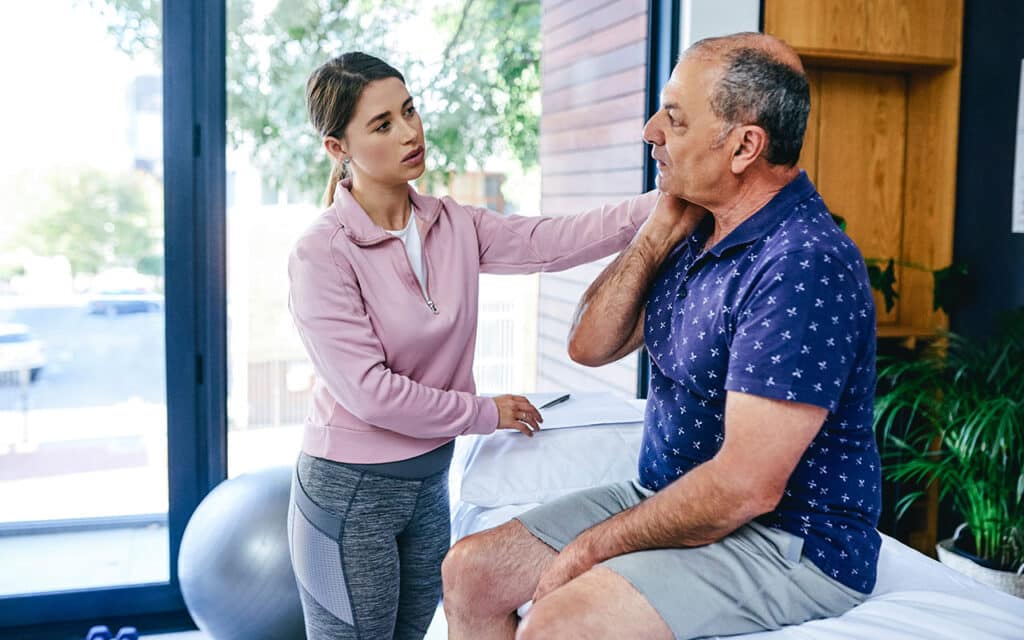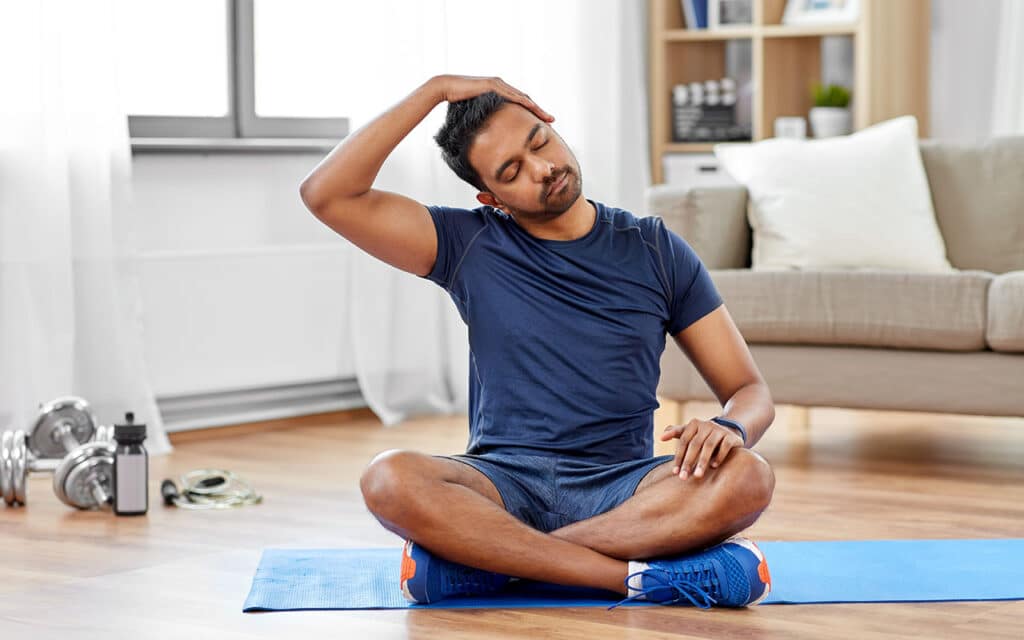- About
Who We Are
Partner With Airrosti
Testimonials
- Locations
Nationwide Care
Our virtual care option, Airrosti Remote Recovery is available nationwide.
Find A Location Nearest You
- Injuries We Treat
- No Cost Assessments
- Virtual Care
- Careers
Our virtual care option, Airrosti Remote Recovery is available nationwide.
(21,000+ reviews on Google across 150+ locations)
Have you heard of Upper Cross Syndrome, but you’re not too sure what it is? Don’t worry – Airrosti’s Brooke Green, DC has your back. Follow along as she explains the common causes and symptoms of Upper Cross Syndrome, as well as what traditional treatment options are compared to Airrosti. Discover if your upper back or neck pain is actually Upper Cross Syndrome by making an appointment with Airrosti today, either in-clinic or virtually.
Although you may not be familiar with the term Upper Cross Syndrome (also known as Upper Crossed Syndrome), you’ve probably seen it. This muscular imbalance condition is often caused by poor posture over an extended period. It results in rounded shoulders, a forward head in front of the body, and an apparent curve in the neck and upper back.
While Upper Cross Syndrome is a condition routinely suffered by the elderly, it is also extremely common in office workers and even athletes. In fact, it’s one of the most common postural problems in both the young and the old.

The muscles of the human body are interconnected. When one muscle becomes weak, another muscle takes over the work. In Upper Cross Syndrome, mid and upper back muscles (serratus and trapezius) become weak. As a result, the pectoral and neck muscles tighten. This causes pain throughout the upper body, including shoulder pain and neck pain, as well as a reduced range of motion.
Simply put, Upper Cross Syndrome is a muscle imbalance caused by the weakening and lengthening of the posterior upper back and neck muscles, combined with the tightening and shortening of the opposing anterior pectoral (chest) and neck muscles. This imbalance can lead to joint dysfunction.
Individuals with a sedentary lifestyle are most at risk for developing Upper Cross Syndrome. Long hours of sitting at a computer, watching television, or using a smartphone can contribute to bad posture. This prolonged poor posture can weaken the rhomboid and neck flexor muscles while tightening and shortening the pectoral and upper trapezius and levator scapulae muscles.
As a result, this is what’s known as the “cross” pattern where the condition gets its name. This imbalance causes the spine to pull forward, significantly increasing the amount of stress on the supporting muscles.
Subsequently, while poor posture and too much sitting are leading causes of Upper Cross Syndrome, it is not uncommon to find this condition in athletes, especially swimmers and weightlifters. This is due to overuse of the muscles around the neck, shoulders, and upper back.

Unlike some conditions, Upper Cross Syndrome often manifests in a very visible way. Many people will notice their shoulders become more rounded and hunched over time, while the neck and head crane forward. The spine will also start to curve inward near the neck and outward in the upper back and shoulder area.
Furthermore, the imbalanced muscles associated with Upper Cross Syndrome put stress on the surrounding muscles, tendons, bones, and joints, causing most people to develop symptoms that include:
Upper Cross Syndrome is a chronic condition that can leave significant muscle imbalances in the body and lead to chronic back pain. If someone develops this muscular imbalance and is regularly active or an athlete, it can lessen their mobility and reduce overall performance. If not treated, the condition can cause damage to the spine from continual pressure on the front of the vertebrae.
As far as options to temporarily alleviate symptoms, you may be recommended to try hot or cold therapeutic options, as well as make changes to your lifestyle or work habits.
However, because chronic poor posture is a leading cause of Upper Cross Syndrome, people with Upper Cross Syndrome may have several problems in their upper back or neck. It is very important to consult with a medical provider, who can recommend the right treatment for you, such as physical or manual therapy.
What’s more, to increase the flexibility of the muscles and joints and ensure a full range of motion, there are muscular adhesions and trigger points that must be removed. Manual treatment should be followed by specific strengthening and stretching exercises to prevent future injury and to further restore strength and function.
Naturally, as with many musculoskeletal conditions, the best way to combat the imbalance is through preventative stretches, exercises, and improved posture. Once the condition has progressed, Upper Cross Syndrome treatment involves the strengthening of the weakened muscle groups and stretching of the tight muscles.

Finally, if you’re experiencing pain and limited range of motion associated with Upper Cross Syndrome, don’t wait to get treated. This muscular imbalance condition can worsen over time, developing into chronic upper back and neck pain. Airrosti can quickly and safely resolve the source of this pain while giving you the tools and knowledge you need to stay pain free.
That being said, if you think you may have Upper Cross Syndrome, visit an Airrosti Provider. Once scheduled, your Provider will provide a thorough assessment of your condition and work to treat your pain at the source, often in an average of 3 visits (based on patient-reported outcomes). In addition, you will be given a personalized treatment plan, as well as supplemental resources and tools to help continue your recovery at home.
Schedule an appointment online, for either in-clinic or virtual options, or call (800) 404-6050 to learn more information.
Read our Medical Disclaimer here.
Reviewed by Casey Crisp, Doctor of Chiropractic
Disclaimer: Always consult with your doctor before starting any exercise program. If you experience any numbness, tingling or reproduction of your symptoms, please contact your doctor.

For about 2 months or so I’ve been having this sort of discomfort/pain in the upper back region and every other day it would be on the right or left side. I went to see Dr. McGowan about it and she began asking all kinds of questions to see what kind of pain or discomfort, in what particular region of the body, how often do I have this discomfort/pain, as well as what could be the issue of it occurring. She managed to figure out where in the upper back the discomfort was located and managed to do a deep tissue massage in order to stretch out that particular muscle and also do a couple of exercises at home and/or at the gym in order to relieve any tension or discomfort in that particular part of the back. So far I feel way better than I...+ show more did a couple months ago. I know for a fact that if I ever need some pain relief or readjustment I’d go to Dr. McGowan.
by Shadai Siguenas
